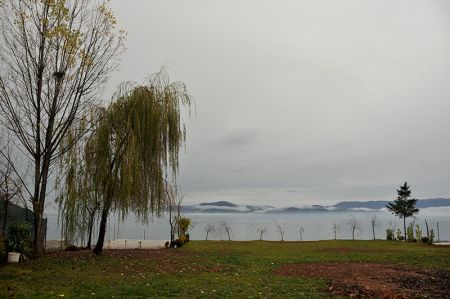Camping on Lake Ohrid near Struga – first steps
- Written by Portal Editor
Family warmth and the first open conversations on the evening of our arrival had caused great interest in our project, so that we had a "long evening" in the small restaurant.
As we probably already suspected, research on the internet brought us into contact with Perparim and his family, who run a small restaurant on Lake Ohrid with a parking lot on the lakeshore. English is spoken, also a little German. So, we were able to use the parking lot to park our caravan, without realizing that this place would one day become a quite idyllic campsite.
Our acquaintance with Marietta van Attekum
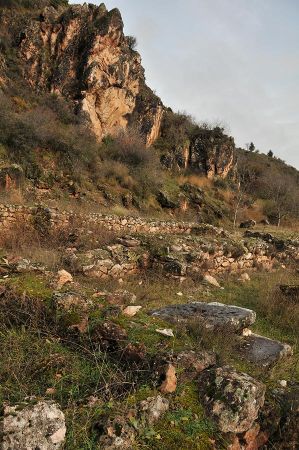 Of course, the Perparim family also knew that the ancient Via Egnatia once ran through Struga, especially since there were some historical ruins in the area, although their functions are not known because they have not yet been researched. We quickly noticed that Perparim's father in particular was quite knowledgeable about the region's ancient past. So, there was great interest when we reported on our acquaintance with Marietta van Attekum, who would like to expand the hiking trail along the Via Egnatia to promote local tourism. At the end of the first evening, we arranged to meet with Perparim to carry out an initial exploration of the immediate area the following morning.
Of course, the Perparim family also knew that the ancient Via Egnatia once ran through Struga, especially since there were some historical ruins in the area, although their functions are not known because they have not yet been researched. We quickly noticed that Perparim's father in particular was quite knowledgeable about the region's ancient past. So, there was great interest when we reported on our acquaintance with Marietta van Attekum, who would like to expand the hiking trail along the Via Egnatia to promote local tourism. At the end of the first evening, we arranged to meet with Perparim to carry out an initial exploration of the immediate area the following morning.
Struga is located on the northern shore of Lake Ohrid, not far from the border with Albania. We were initially amazed when we drove through the town with Perparim the next morning and saw the Albanian flag flying on many houses. Struga has around 16,700 inhabitants, of which around 5,300 are ethnic Albanian, and the city also has around 900 ethnic Turkish residents. Accordingly, Struga is today mainly influenced by two religions: Orthodox Christianity and Sunni Islam, living side by side peacefully and respectfully.
Stone tools, bones and weapons from the early Stone Age were found.
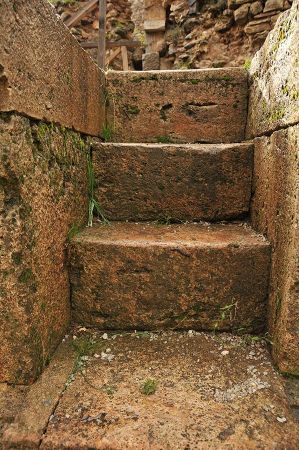 We drive along the lakeshore and learn that during the Neolithic, comparable to Lake Constance, there were the first settlers who founded pile-dwelling settlements on the shores of Lake Ohrid and made a living from fishing. Stone tools, bones and weapons from the early Stone Age were found.
We drive along the lakeshore and learn that during the Neolithic, comparable to Lake Constance, there were the first settlers who founded pile-dwelling settlements on the shores of Lake Ohrid and made a living from fishing. Stone tools, bones and weapons from the early Stone Age were found.
The fishermen belonged to the Illyrian Brygian and Enchelean ethnic groups, and the city that developed from the pile dwellings was accordingly called Enhallon. From the works of the historian Polybius we know that Enhallon, like Lychnidos, modern Ohrid, was conquered by Philip II in 359 BC and thus belonged to ancient Macedonia. With the "takeover" by the Romans in 148 BC, the Via Egnatia was created, which also led through Enhallon, i.e. Struga.
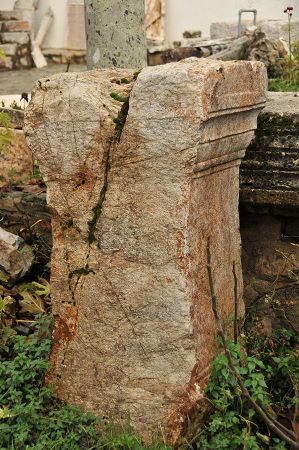 Unfortunately, the exact route of the Roman road along Lake Ohrid has not been researched, but it can be assumed that there must have been a larger loop, as the shore region must have been quite swampy due to the outflow of the Black Drin River.
Unfortunately, the exact route of the Roman road along Lake Ohrid has not been researched, but it can be assumed that there must have been a larger loop, as the shore region must have been quite swampy due to the outflow of the Black Drin River.
A little later, Perparim takes us to the ruins of a building that must have once been a basilica. From the 3rd century AD, Christianity spread very quickly. The ancient Roman temples were destroyed, large parts of the existing building material were used and the first basilicas were built on the old foundations. There are a number of such ancient ruins in the area around Struga, including the Church of Saint Erasmus, located about nine kilometres east of the city centre on the road to Ohrid, which is considered to be the first Christian mission in the area.
Numerous such ancient ruins in the area around Struga
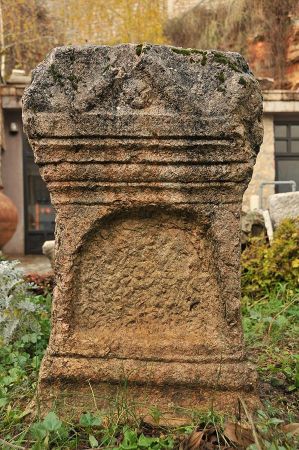 When the Ottomans conquered the Lake Ohrid region around 1394, Sunni Islam came with them to the Balkans, and Sufists also immigrated every now and then and founded their Tekken. The Venetian ambassador Lorenzo Bernardo, who is also known for writing diaries, spent a night in a caravanserai near Struga during a trip from Venice to Constantinople from May 21st to 22nd, 1591. He describes the city more as a village, but praises the plain on Lake Ohrid as extremely fertile, and he also praises the local wine and the special Ohrid trout as extremely tasty. In 1668, the Ottoman travel writer Evliya Celebi came to the city.
When the Ottomans conquered the Lake Ohrid region around 1394, Sunni Islam came with them to the Balkans, and Sufists also immigrated every now and then and founded their Tekken. The Venetian ambassador Lorenzo Bernardo, who is also known for writing diaries, spent a night in a caravanserai near Struga during a trip from Venice to Constantinople from May 21st to 22nd, 1591. He describes the city more as a village, but praises the plain on Lake Ohrid as extremely fertile, and he also praises the local wine and the special Ohrid trout as extremely tasty. In 1668, the Ottoman travel writer Evliya Celebi came to the city.
He describes the place as progressive, with as many as 301 two-story houses and 40 shops, all with tiled roofs and surrounded by orchards and vineyards. Celebi also describes a wooden bridge over the Drin, which was built on 12 pillars as a personal seraglio, i.e. his personal palace by the large landowner Emin Agha.
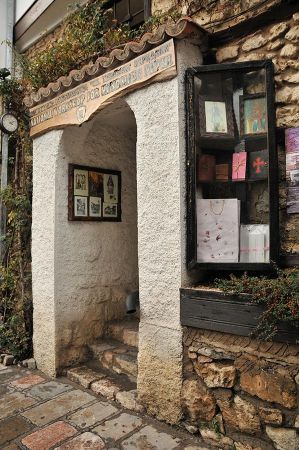 The Sunni Great Mosque in the old town of Struga as well as the Halveti-Hayati-Tekke of a Sufi order date from this period.
The Sunni Great Mosque in the old town of Struga as well as the Halveti-Hayati-Tekke of a Sufi order date from this period.
As we drive through the city, we notice the still existing influence of Ottoman architecture quite clearly; the two-story houses are typical. Unfortunately, as our city guide reports, many of the historic houses in the city centre have been demolished and replaced by "modern" buildings and restaurants.
For years, the authorities have hardly taken any action against illegal and uncontrolled construction. Noteworthy is the large bazaar in the west of the city, which is one of the largest weekly markets in the region. Of course, fish is an essential part of the market offering here.
Struga also called “City of Bridges”.
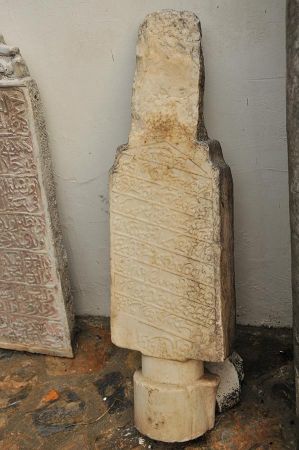 Five bridges that are popular with local residents lead over the Black Drin, which is why Struga is also called the “city of bridges”. In summer, the city centre and the stand area are popular excursion destinations for tourists from the surrounding area, but also from neighbouring countries. So, it's no wonder that restaurants, bars and cafes were able to expand significantly.
Five bridges that are popular with local residents lead over the Black Drin, which is why Struga is also called the “city of bridges”. In summer, the city centre and the stand area are popular excursion destinations for tourists from the surrounding area, but also from neighbouring countries. So, it's no wonder that restaurants, bars and cafes were able to expand significantly.
At the end of our tour, Perparim takes us to an ancient rock church, which is not initially recognizable as such because the rock church is hidden by a relatively new building. A normal staircase leads first up to the second floor, then through narrow corridors and a steep staircase back down into the rooms of the rock church. We would love to find out more at this point, unfortunately there has been a lack of research and corresponding findings to date.
We drive back to the restaurant to first process what we had seen and by the way, we not only got closer to each other, but were also able to put our first tourist thoughts into consideration. A trip to Ohrid is already planned for the next day.
Please read as well:
Cistern "Illos" in Akkale, the "White Castle" near Kizkalesi
Cendere Köprüsü - the bridge over the Chabinas
https://www.alaturka.info/en/macedonia/struga/6358-camping-on-lake-ohrid-near-struga-first-steps#sigProIda69ffc8fee
